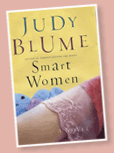Smart Women (New Intro)

In 1979 I was divorced and living in Santa Fe, New Mexico with two teenagers. I was thankful for my work, but convinced I would never find a lasting love relationship, when bam! – it hit me all over again. Falling in love at 40 (or any age) is s’wonderful, just like the song says. But this time around you bring all that baggage with you, not to mention your kids, who might not think it’s all as romantic as you do. What teenager wants to know anything about mom or dad’s sex life?
This was the seed that started me writing Smart Women.
When I began to write the book, I planned to tell the story from the adults’ viewpoint only, and although there would be kids in it, this time I wasn’t going to take their side. But once I got going I fell in love with both Sara and Michelle, daughters, respectively, of the two main characters, B.B. and Margo. I had to let them have their say. They provide the humor and poignancy in the story.
While my children were growing up I was careful not to use them in my books – careful of their privacy. But my daughter believes that Michelle is based on her (when she was that age) and maybe she’s right. Maybe that’s why Michelle is my favorite character in the book. I love her vulnerability. I love her for giving her mother a hard time because she cares about her and can’t bear to see the family painfully disrupted again. Is there any relationship more complicated than that of mothers and daughters, especially when mom is divorced and dating?
Smart Women takes place in the early eighties, a time when some of us thought we could have it all. We celebrated what we called our freedom. I’m not sure what we thought personal freedom meant, but it certainly included sexual freedom (this was before we knew the dangers of sexually transmitted diseases, including AIDS). Freedom was a word we bandied about, telling ourselves we deserved it, we’d worked long and hard to get it.
 Freedom didn’t mean freedom from responsibility, because we had children and most of us cared deeply about them. Maybe it meant freedom to make our own decisions, to make our own mistakes. There’s a scene in the book in which Margo sits in the bathtub singing the lyrics Kris Kristofferson made famous: “Freedom’s just another word for nothin’ left to lose.” But is that what we really believed?
Freedom didn’t mean freedom from responsibility, because we had children and most of us cared deeply about them. Maybe it meant freedom to make our own decisions, to make our own mistakes. There’s a scene in the book in which Margo sits in the bathtub singing the lyrics Kris Kristofferson made famous: “Freedom’s just another word for nothin’ left to lose.” But is that what we really believed?
Sure, we were proud of our work, proud we could support ourselves, and we weren’t about to stay in bad marriages. Why should we? (Just look at the statistics: Our generation married young and divorced often.) But when it came right down to it, most of us still wanted a man in the house, a man in our beds – just not the man we married the fi rst time. We wanted one of those new and enlightened types, the kind we’d been reading about. But who were these men? Where were they? In Margo’s case, he’s the ex-husband of her new friend and he’s come to town to spend time with his young daughter.
Of course, everyone who knew me assumed the story was all true since George, the man in my life, was the former husband of a new friend. (She’s the one who fixed us up: How civilized is that? How eighties?) But all the characters in the book (okay, except for some parts of Michelle) are fictional. Really!
Once I started writing Smart Women I realized I needed to set it outside Santa Fe. I needed a town that wouldn’t intrude on my story. Santa Fe was too strong a setting and besides, we lived there; our children went to school there. Until then, I’d never set a book in a place I didn’t know well. My friends were anxious to help in my quest for the perfect setting, sharing their enthusiasm for Mendocino, Port Townsend, Telluride. George and I checked out their suggestions, but none of them felt right.
